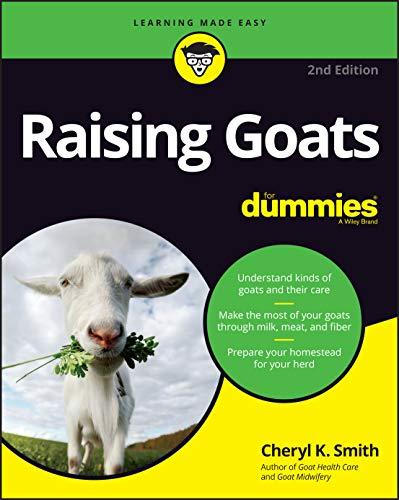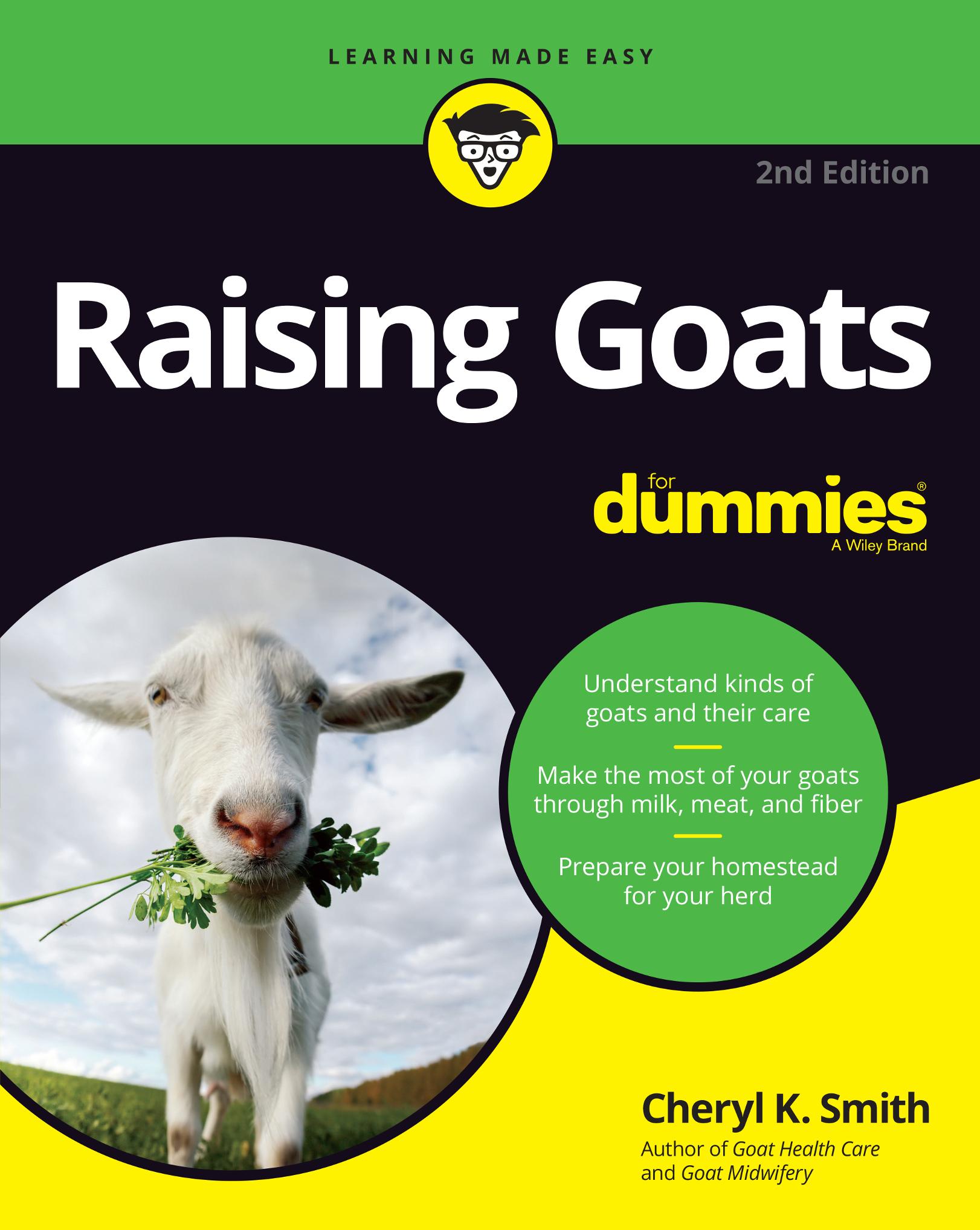Raising Goats For Dummies®, 2nd Edition
Published by: John Wiley & Sons, Inc., 111 River Street, Hoboken, NJ 07030-5774, www.wiley.com
Copyright © 2021 by John Wiley & Sons, Inc., Hoboken, New Jersey
Published simultaneously in Canada
No part of this publication may be reproduced, stored in a retrieval system or transmitted in any form or by any means, electronic, mechanical, photocopying, recording, scanning or otherwise, except as permitted under Sections 107 or 108 of the 1976 United States Copyright Act, without the prior written permission of the Publisher. Requests to the Publisher for permission should be addressed to the Permissions Department, John Wiley & Sons, Inc., 111 River Street, Hoboken, NJ 07030, (201) 748-6011, fax (201) 748-6008, or online at http://www.wiley.com/go/permissions
Trademarks: Wiley, For Dummies, the Dummies Man logo, Dummies.com, Making Everything Easier, and related trade dress are trademarks or registered trademarks of John Wiley & Sons, Inc., and may not be used without written permission. All other trademarks are the property of their respective owners. John Wiley & Sons, Inc., is not associated with any product or vendor mentioned in this book.
LIMIT OF LIABILITY/DISCLAIMER OF WARRANTY: THE PUBLISHER AND THE AUTHOR MAKE NO REPRESENTATIONS OR WARRANTIES WITH RESPECT TO THE ACCURACY OR COMPLETENESS OF THE CONTENTS OF THIS WORK AND SPECIFICALLY DISCLAIM ALL WARRANTIES, INCLUDING WITHOUT LIMITATION WARRANTIES OF FITNESS FOR A PARTICULAR PURPOSE. NO WARRANTY MAY BE CREATED OR EXTENDED BY SALES OR PROMOTIONAL MATERIALS. THE ADVICE AND STRATEGIES CONTAINED HEREIN MAY NOT BE SUITABLE FOR EVERY SITUATION. THIS WORK IS SOLD WITH THE UNDERSTANDING THAT THE PUBLISHER IS NOT ENGAGED IN RENDERING LEGAL, ACCOUNTING, OR OTHER PROFESSIONAL SERVICES. IF PROFESSIONAL ASSISTANCE IS REQUIRED, THE SERVICES OF A COMPETENT PROFESSIONAL PERSON SHOULD BE SOUGHT. NEITHER THE PUBLISHER NOR THE AUTHOR SHALL BE LIABLE FOR DAMAGES ARISING HEREFROM. THE FACT THAT AN ORGANIZATION OR WEBSITE IS REFERRED TO IN THIS WORK AS A CITATION AND/OR A POTENTIAL SOURCE OF FURTHER INFORMATION DOES NOT MEAN THAT THE AUTHOR OR THE PUBLISHER ENDORSES THE INFORMATION THE ORGANIZATION OR WEBSITE MAY PROVIDE OR RECOMMENDATIONS IT MAY MAKE. FURTHER, READERS SHOULD BE AWARE THAT INTERNET WEBSITES LISTED IN THIS WORK MAY HAVE CHANGED OR DISAPPEARED BETWEEN WHEN THIS WORK WAS WRITTEN AND WHEN IT IS READ.
For general information on our other products and services, please contact our Customer Care Department within the U.S. at 877-762-2974, outside the U.S. at 317-572-3993, or fax 317-572-4002. For technical support, please visit https://hub.wiley.com/community/support/dummies.
Wiley publishes in a variety of print and electronic formats and by print-on-demand. Some material included with standard print versions of this book may not be included in e-books or in print-on-demand. If this book refers to media such as a CD or DVD that is not included in the version you purchased, you may download this material at http://booksupport.wiley.com. For more information about Wiley products, visit www.wiley.com
Library of Congress Control Number: 2021930797
ISBN 978-1-119-77258-3 (pbk); ISBN 978-1-119-77259-0 (ebk); ISBN 978-1-119-77260-6 (ebk)
Manufactured in the United States of America
10 9 8 7 6 5 4 3 2 1
Part 2: Bringing Your Goats Home
Part 3: Managing Goat
Breeding
Part 4: Making Your Goats Work for You
Part 5: The Part of Tens
Looking After Pregnant
Making sure not to talk with your neighbor
Remaining calm even if your goat is misbehaving
Foolish Assumptions
When writing this book, I made some assumptions about who you, the reader, might be. I assume that you
» Are already planning to get some goats or have a few and want to find out more about caring for them
» Are interested in the basics of raising goats for milk, meat, fiber, backpacking, or pets
» Want to produce some of your own food so you can control the quality and what goes into it
» Don’t know much about goat health care and plan to work with a veterinarian when your goats get sick
» Want to save money by building some of the structures and supplies your goats need
Beyond the Book
In addition to the material in the print or e-book you’re reading right now, this product also comes with some access-anywhere goodies on the web. Check out the free Cheat Sheet for tips on preparing your property for goats, the signs of a sick goat, and the questions to ask before buying a goat. To access the Cheat Sheet, go to www.dummies.com and type Raising Goats For Dummies Cheat Sheet in the Search box.
Icons Used in the Book
Throughout this book, little pictures in the margins draw your attention to special types of information that make your reading experience more helpful. Here’s what you find:
Some information bears repeating, and I highlight it with this icon. Important points that you may turn to again and again appear next to it.
The information you find next to this icon is more detailed than usual. When you see it, feel free to move on. You won’t lose out on main points.
Beside this icon are nuggets of important information that help you to be a better goatkeeper. I use this icon to show you ways to save time or money — or both.
This dangerous-looking icon draws your attention to potential bad outcomes or mistakes that you want to avoid. Pay close attention to them.
Where to Go from Here
Pick a chapter, any chapter. Each one is its own little book. You won’t need to go back to fill in missing pieces from earlier chapters. Looking for information about what to expect from kidding? Turn to Chapter 13. Want to glimpse the details of caring for goats? Chapter 9 has what you need. And if you’re an overachiever or just insatiably curious, by all means turn the page and keep going until you get to the back cover.
I imagine that the more you find out about goats, the more likely you are to fall in love with them. They’re smart, curious, and calming, and they can even help you make some money. So welcome to the world of goats. I’m grateful for the opportunity to help you on your quest.
THANK GOATS FOR COFFEE
According to legend, goats in the charge of an Ethiopian goatherd named Kaldi failed to return one evening. When he found them the next morning, they were excited and dancing next to a shrub covered in red berries. He investigated, trying the berries, and discovered that they were responsible for the goats’ excitement. The goats had discovered coffee.
When the goatherd took the berries to the town monastery, the abbot disapproved and threw them into the fire. When he smelled the pleasant odor they gave out as they roasted, he raked them out of the fire, ground them up, and mixed them with water. Coffee’s use as a stimulant drink gradually spread around the world.
Goats still enjoy coffee, and some goat owners use it to stimulate labor and give energy to a doe (female) that is kidding.
These critters can live for ten years or more, so getting goats is like getting a dog — you may be taking care of them for quite a while. Chapter 2 tells you about their life expectancy.
Identifying the Benefits of Owning Goats
Goats are fantastic animals that have been domesticated for more than 10,000 years. You get a lot from a relatively small animal — you can milk them or eat their meat, use their fiber and their skin for making clothing, and even use their dung for fuel (if you are so inclined). In the past, goat hide was made into bags for carrying water and wine and parchment for writing on; it is still used to make drums in some countries.
You may want to raise goats for a variety of reasons. Whatever brings you to goats, you’re guaranteed to find additional benefits to owning these critters after you start working with them.
Becoming more self-sufficient
Goats are not only a great way to become more self-sufficient — they can give you milk to drink and food to eat, and even help you carry your belongings when backpacking — but they teach you in a very direct way where your food comes from and give you an opportunity to affect its quality. If prices go up (and don’t they always?) you are less affected if you’re supplying some of your own food.
And imagine not ever having to cut down blackberries or kudzu again. You can get your friendly goat to do it for you, while growing fiber for hats and sweaters and providing you with milk, meat, and even more goats.
In this section I talk about the many ways goats can contribute and move you toward self-sufficiency.
Cutting your dairy bill
Imagine never having to buy milk or cheese again. If you raise dairy goats you can achieve that goal. Your goats need to have kids to give you milk, and then you can milk them throughout the year for up to five years without rebreeding, if you want. Or you can stagger the kidding each year so that you have a milk supply year-round. (They need a break from milking during the last two months of their pregnancy to put their energy into growing kids.)
You need only a few goats to keep a small family in milk and other dairy products. Just one standard-size dairy goat can give you an average of 6 to 8 pounds (3 to 4 quarts) of milk each day. And, depending on the butterfat content of the milk, you can get up to a pound of cheese for every gallon of milk.
With your own milk supply, you won’t need to worry about additives to the milk you drink or the cheese or yogurt you eat. Goat milk is easier to digest than cow milk, and so it is prized by people who can’t drink cow milk. Depending on the state you live in, you can sell milk to supplement your income or offset the goats’ feed costs.
You find out about raising goats for milk in Chapter 15.
Raising your own meat
Goat meat has always been popular in the developing world, because goats are much more affordable and use fewer resources than animals such as cows. According to the U.S. Department of Agriculture, the demand for goat meat is expected to continue growing.
People who moved to the United States from Latin America, the Caribbean, the Middle East, Asia, and Africa brought their custom of eating goat meat as a regular part of their diet and still want it. And more people who hadn’t eaten goat meat before are willing to try a new, lean source of protein that doesn’t have the taint of confined animal feeding operations (CAFOs). Animals raised in CAFOs often never see the light of day and are unable to exercise or eat grass because they are packed into small areas.
DRINKING MILK ON THE FARM MAY HELP YOU BREATHE EASIER
A number of studies have shown a positive correlation between living on a farm and not having allergies or asthma. One study goes even further, showing a likely benefit of raising goats for their milk.
A 2017 study of farmers and their spouses in the United States looked at correlation between a tendency to develop allergies and exposures to a farming environment (including early childhood farm animal contact and raw milk consumption). The results backed up earlier studies from Europe showing a decreased tendency to develop allergies when in a farming environment. This was especially true in cases where their mothers had performed farm activities while pregnant, as well as when they drank raw milk and were exposed to farm animals before the age of 6.
Goat meat is easily digestible, tasty, and low in fat. If you’re in charge of your own source of meat, you know how the animal was raised and what feed or medications went into the animal.
Meat goat farming provides a great opportunity to start a business or supplement your income. You can raise goats that are bred for meat, or you can use your excess dairy bucks (males) or wethers (bucks that have been castrated) as an alternative to buying meat or to provide income to support your herd. Before you jump into a meat-goat enterprise thinking that you’re going to get rich, you need to investigate a few things:
» Check out the market for goat meat in the area of the country where you live. Contact your extension office for assistance, go to the local livestock auction to see how well and for what price meat goats are selling, and read the local agriculture newspaper or other publications to see what they have to say about raising and marketing meat goats.
» Learn about stocking (the number of animals you can support without overcrowding or overgrazing), how many goats you can stock on your property, and how that might break down in terms of income.
» Determine what kind of meat goats are available and for what price.
» Consider slaughter options. Would you slaughter goats yourself, sell them at auction, have a mobile slaughter provider come out, or transport your goats to a slaughterhouse? Do you have a vehicle to transport goats? Is there a USDA-certified slaughter facility nearby that handles goats? Factors affecting this decision include laws governing slaughter as well as the local market, your capabilities, and financial considerations.
I talk in much more detail about raising goats for meat in Chapter 16.
Growing your own fiber
Some of the finest fiber comes from goats: Angora and Pygora goats produce mohair, cashmere goats produce cashmere, and crosses between the two breeds produce a fiber called cashgora. An adult angora goat can produce an average of 8 to 16 pounds of mohair each year, and a kid can produce 3 to 5 pounds. Cashmere and cashgora-producing goats produce less fiber, but it is also more highly valued.
If you raise fiber goats, you can spin your own yarn and make hats, blankets, sweaters, or other products. You can also sell the fiber to spinners or to companies that make these products, while having the benefit of these friendly creatures.
Check out Chapter 18 to find out about harvesting and using goat fiber.
Harnessing goats’ power as living weed whackers
Goats are well-known for their ability to wipe out weeds. In fact, some people have made businesses out of renting out their goat herds to cities and other municipalities to clean up areas that are overgrown with weeds or blackberry bushes. These leased goats decrease the need to use herbicides, improve the soil’s fertility, decrease the risk of fire, increase the diversity of plants in the area, and control weeds in hard-to-reach areas, such as steep hills.
Because goats are browsers, they can share or alternate a pasture with sheep or cattle, which prefer different plants. Goats eat brush, leaves, and rough plants. They can improve pasture by removing noxious weeds, clear areas to be replanted with trees, and control leafy spurge, knapweed, Himalayan blackberry, giant ragweed, sunflowers, kudzu, and other weeds.
Not every plant is a great snack for a goat. I tell you about plants you need to keep away from your goats in Chapter 4.
Whether your goats are pets, milk producers, meat animals, or serve another purpose, they provide the side benefit of acting as living weed whackers. With some portable fencing or a guardian animal for protection, they range far and wide each day to keep your property free of noxious weeds.
Don’t expect to put them on a lawn and have them mow down the grass, though. “Lawnmower” is the job of sheep, not goats. Goats prefer to eat your rosebushes or lilacs.
CASHMERE GOATS
No specific breed of goat is named cashmere. However, feral goats from Australia and New Zealand and Spanish meat goats from the southwestern United States can be registered with the Cashmere Goat Association, if they meet the standard. Breeders have produced more productive cashmere goats by selectively breeding good producers from these populations. Cashmeres have the added benefit of being good meat goats.
The term cashmere refers to the undercoat or down that is harvested from a variety of goats. Cashmere is harvested and processed mainly in central Asia, especially China. The fiber produced by up to four of these Asian feral goats in a whole year is required to make just one cashmere sweater — which explains why they are so expensive.
Breeding and selling
Unless your goats are just pets or brush eaters, you probably want to breed them. If you have dairy goats, you need to breed them to keep a good supply of milk flowing. And you will need to replace any goats you sell or slaughter.
As a dairy goat owner, I supplement my income from selling milk by selling kids and providing buck service. Buck service means leasing a buck for breeding purposes to another goat owner. Buck service is valuable to goat owners who don’t have the space or don’t want the hassle of keeping a buck or who want to get certain genetics into their herd. I tell you more about buck service, and about breeding in general, in Chapter 12.
Using goats for companions or helpers
Goats make great companions, something that more people discover every day. Miniature goats such as the Nigerian Dwarf, Pygmy, and mini dairy breeds are growing in popularity as pets, in both the city and the country. (Check out Chapter 3 to find out more about these and other breeds.)
Goats are intelligent and funny, and they’re also a great way to meet people. I had a little goat named Malakai, who was a dwarf Nigerian Dwarf, because of health issues. His petite size made him all the more adorable. He was house- and car-broken, and so I took him with me wherever I went. He was the little Mystic Acres farm emissary and never failed to attract people. Besides helping me meet people, Malakai gave me the opportunity to educate people about goats and clarify their inevitable misunderstandings. (Get into goats, and you’ll find that misconceptions abound. I brace you to take on the most common of them in Chapter 20.)
Keeping goats as pets
Normally considered livestock, goats can make good pets, but you will be much more satisfied using them for this purpose if you remember that they are outdoor animals and that’s where they do best. Goats are herd animals and need another goat for a friend, so get at least two of them. I tell you more about choosing your goats in Chapter 5.
You can leash train goats and take them on walks throughout the neighborhood or around your property, which provides exercise for all of you. (Chapter 8 shows you how to get started leash-training.) I can tell you from experience that just sitting and watching goats has a calming effect. Studies of other pets have shown that they can lower your heart rate and improve your health — and I’m sure that the same is true for goats as pets.
Finding a helping hoof: Using your goat for packing
Goats are social animals and, after you establish a relationship with them, they love to spend time with you. They enjoy going for hikes and can go almost anywhere you can. Not only that, but they can carry your belongings, they find plenty to eat right there in the wilderness, and they make great companions.
So why not take your goat packing? Ideally, you select a large wether for packing and then take the time to train him to obey commands and to carry your gear. Goats are surefooted, excellent pack animals and can help you work, whether it be gathering wood in the forest or just carrying your belongings on a holiday hike. Chapter 8 tells you about training your goat as a pack animal.
Sharing your goat with others
Another way you can use a companion or pet goat is as a therapy animal or a visitor to children, seniors, or other groups who don’t usually see goats. After you train your goats, you can approach teachers, administrators, or activity directors to plan a goat day (or hour). You get to spend time with your goats, and other people get to learn about their unique personalities.
Some people use goats to help children with autism improve their sensory abilities and social skills — there’s nothing like a cute pet to get people talking to you — and to improve morale and entertain residents of nursing homes. (I talk more about these benefits in Chapter 18.)
Raising goats as a 4-H project
Getting children involved in raising goats is a good way to teach responsibility. Keeping goats requires twice-a-day chores. Children quickly learn that the goats depend on them. They also find out about the cycle of birth and death and get outdoors to get regular exercise.
Learning about and caring for goats as a 4-H project provides a structure that makes caring for goats fun and easy by giving the project a bigger purpose. Contact your county extension office for help on finding a 4-H group. If the 4-H group in your area is not set up so your kids can raise goats for a project, consider getting trained and starting your own goat 4-H group. Doing so not only gives your kids the opportunity for such a project, but it teaches responsibility, helps promote goats, and educates other children.


















